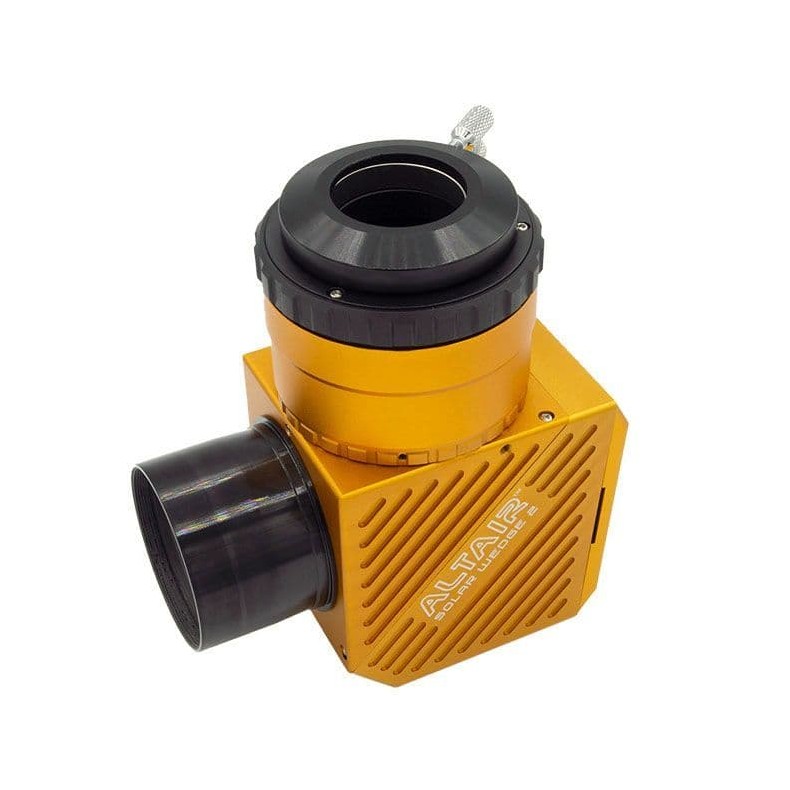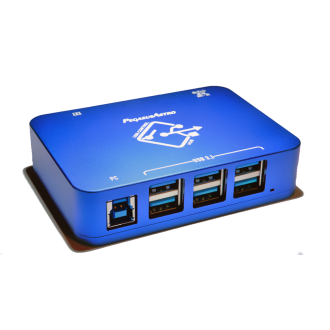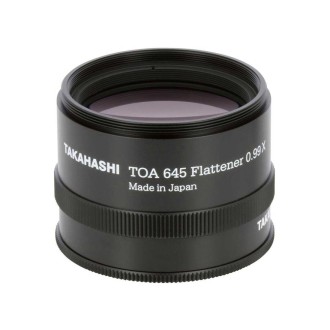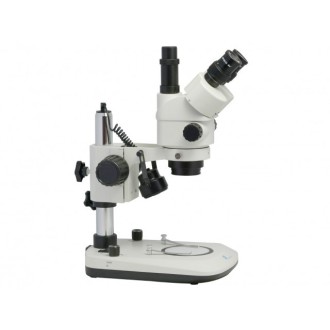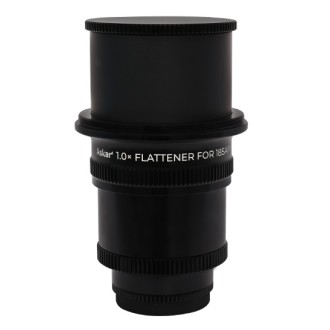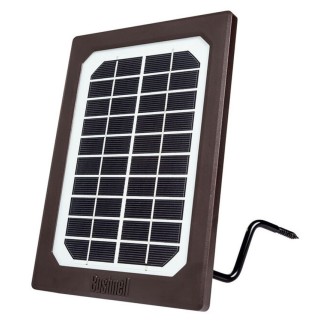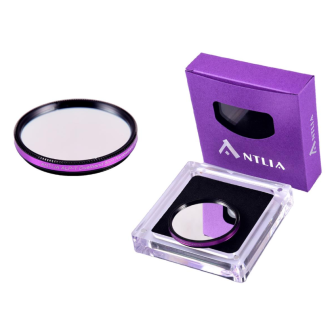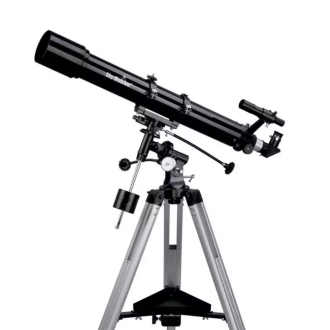
Herschel Solar Altair 2024 Eclipse Version prism for refractors. The Herschel Solar Altair prism (Herschel prism) replaces the normal 2" diagonal mirror of your refractor telescope. The solar prism transmits a very small and safe amount of light to the eyepiece or camera.
| Carrier | Description | Estimated Delivery | ||
|---|---|---|---|---|
 |
Home delivery - International | Home delivery - International |
Friday, 6 June - Friday, 13 June |
|

Home delivery - International
Home delivery - International
Estimated delivery:
Friday, 6 June - Friday, 13 June
Please note that this product is designed for use with REFRACTORS ONLY, and is not intended for use with reflector or catadioptric telescopes.
Altair 2" Solar prism features:
- 1.25" - 2" Push-fit adapter.
- Ceramic diffuser on the back that aids alignment and controls heat, allowing use with refractors up to 5" all day without overheating.
- Safely uses Altair contrast filters such as G-Band or Altair 540nm, Altair NUV, CaK with cameras or eyepieces.
- Unlike other brands, the Altair Solar Wedge allows both visual and imaging applications without having to change internal filters to adjust brightness. The top section can be rotated to adjust the brightness level to suit your accessories or camera.
The Herschel Altair Solar Prism is "imaging ready" because it can precisely adjust image brightness without disassembling the camera for the best exposure, gain and contrast settings. This is ideal for "lucky image" CMOS cameras such as the Altair Hypercam or GPCAM series. Using filters such as Altair G-Band, Altair 540nm Continuum and Altair NUV is made easier by the brightness control.
It is well known that solar prisms provide a sharper, higher contrast image than traditional front-mounted metallized solar film. This is achieved by eliminating reflections between the filter and the telescope lens. The result is a sharper, higher-contrast view of sunspots, including solar photosphere features such as granulation. Sunspot centers appear much darker black compared to those seen with solar film filters, and many customers report never having seen the finer structures before. The difference is quite noticeable and immediately visible in the eyepiece. The Altair solar prism has special anti-reflection coatings on the internal polarizing filter and on the prism. A high specification prism provides the ultimate in sharpness and resolution for imaging and observation.
Safe and easy to use: cheaper solar prisms direct excess energy to the ground or, worse, heat a metal block on the back that can burn you. The Altair Imaging-Ready solar prism directs energy into a special extra-thick polycrystalline ceramic diffuser disk at the back of the prism. Ventilation holes allow air circulation by convection. The polycrystalline disk has the added advantage of being translucent to some extent, so it acts as a sort of narrow-field "solar seeker". It does not completely replace the Altair solar finder, but works in tandem with it, allowing final adjustments even with a high-power eyepiece installed. The sun appears projected on the back of the diffuser as a bright light.
one prism does it all! For both solar photography and visual observation: solar prisms often do not give enough light for high-speed exposures needed to "freeze" air movement and get a sharp image. The Altair solar prism has an internal polarizing filter with AR coating, which allows you to control the brightness of the image. Brightness can be increased or decreased by turning the upper turret assembly and locking it in the desired position with a thumbscrew. Variable brightness is very important for both visual and imaging use, to fine-tune the ideal exposure time, or ideal contrast levels at the eyepiece - especially when adding a color filter such as the Altair 540nm continuous filter, or the G-Band filter for extra contrast. Unlike other brands, the Altair solar prism allows for both visual and imaging applications without having to change internal filters to adjust brightness. With the solar prism in "bright" mode, exposure times as low as 2 milliseconds are routinely possible with high-speed CMOS cameras such as the Altair Hypercam or GPCAM. This "freezes" the seeing (air movement) and results in an incredibly sharp image.
Altair Solar Prism Questions and Answers:
Q: How can I safely observe the sun with a telescope and a filter or Solar Prism?
A: Looking at the sun through a telescope or binoculars without a professional filter will result in immediate and permanent eye damage. This has deterred people from exploring this fascinating subject, however, observing the sun is perfectly safe, as long as you use your filter equipment correctly. Each prism comes with instructions that should be read and fully understood before using the product. Never allow children to observe the sun with a telescope and prism or filter without competent adult supervision. Never remove a solar filter or prism without first attaching the front lens cap to the telescope. Always securely attach solar filters or solar prism to the telescope. Always remove any optical finder from the telescope before pointing it at the sun, as you could inadvertently look through it. We recommend using the Altair safe solar finder with any solar filter or solar wedge. Code: SOLARFINDER).
Q: What telescopes can I use with a Herschel solar prism?
A: Only refracting telescopes up to 6" (152mm) aperture can be used with the Altair Herschel Solar Prism. Refractor telescopes have a front lens and no mirrors. It is dangerous to use ANY telescope with mirrors with a Herschel Solar Prism. This includes Maksutov Cassegrains, Schmidt Cassegrains, Newtonians and Ritchey Chretiens, among others. If in doubt, please contact Altair Astro or your authorized dealer.
Q: Can I use color filters with the Altair Solar Prism?
A: Yes, but only if they are placed AFTER the prism. NEVER add ANY filter in front of a Solar Prism, because it will crack or melt due to the concentrated heat of the sun, and can deposit metal vapor on the back of the objective lens. Never place a filter, Barlow lens or flattener/reducer in front of the prism.
Q: How can I "adjust" the image brightness for "lucky imaging"?
A: Being designed for visual or imaging use, the internal polarizer module (controlled by rotating the top of the turret) has a wider brightness range than normal Hershel prisms, allowing fast frame rates and short exposure durations suitable for "lucky imaging". When imaging the Sun using "lucky imaging" techniques with a high frame rate camera such as the Altair Hypercam, it is best to keep the camera exposure duration as short as possible, ideally below 15 milliseconds for apertures up to 100 mm and faster for large apertures. This "freezes" air movement to show graininess and other small details. When set for fast frame rates, the image can appear very bright visually through an eyepiece, as if looking at a light bulb. This is uncomfortable, but not dangerous due to the protective ND filter attached to the unit. CMOS cameras can be used at full brightness. If you are using the prism for imaging only, just insert the camera and rotate the turret until you are satisfied with the exposure duration and gain settings. If you are using the Altair G-band, NUV or CaK filters, it is recommended that you take images at maximum brightness.
Q: What if I drop or disassemble the product?
A: Do not use the product unless it is in perfect condition. Always contact Altair service or distributor first.
Q: What filters can be used behind the solar prism?
Altair G-Band, Altair 540nm, Altair CaK and Altair NUV filters can be used behind the wedge to increase contrast and highlight various solar features.
Note: Altair Astro and its distributors reserve the right to change product specifications and pricing without prior notice.

